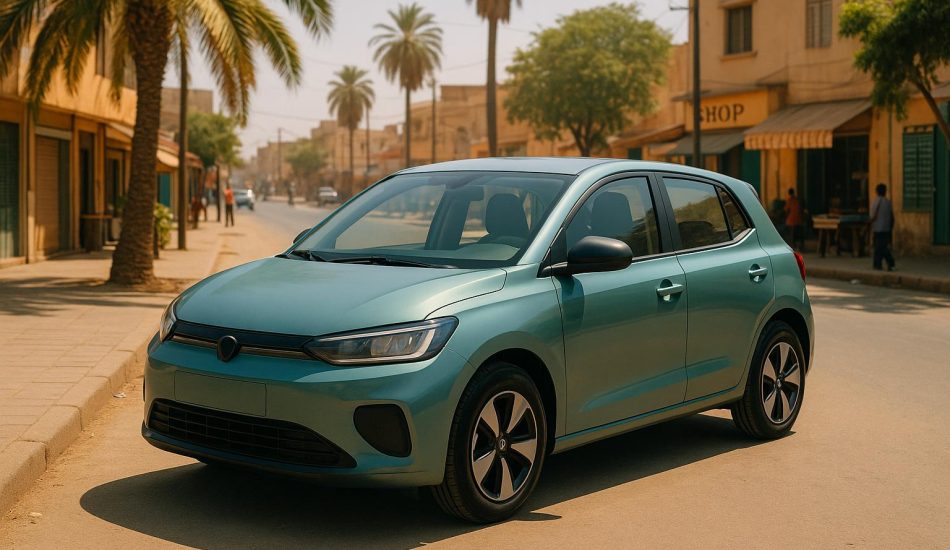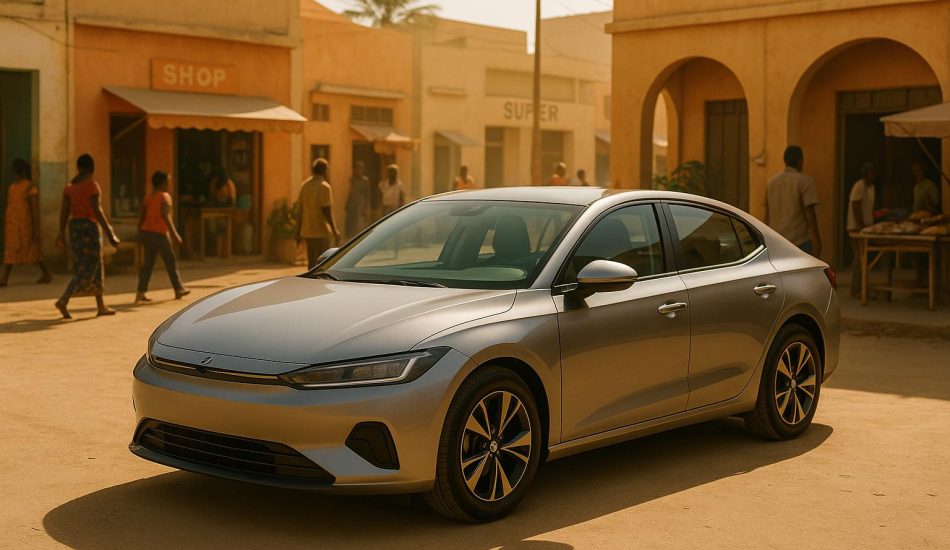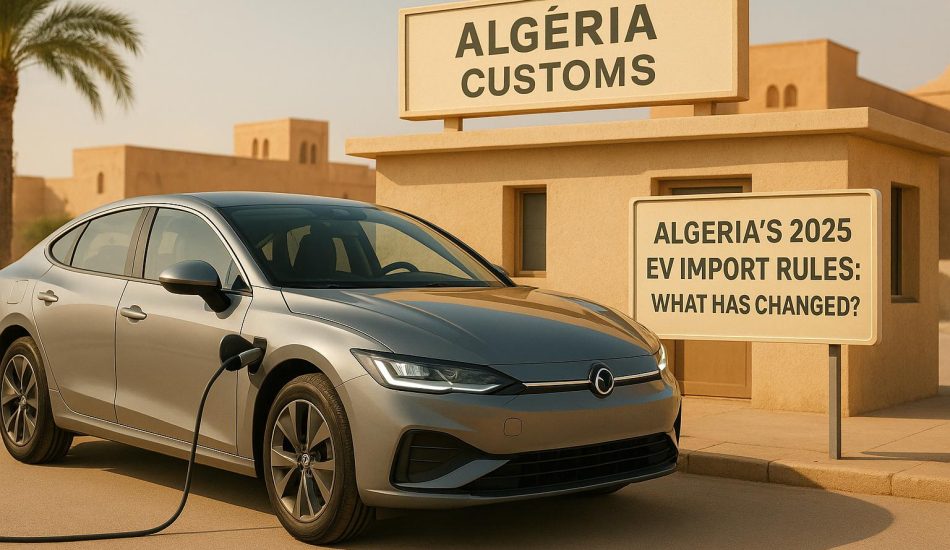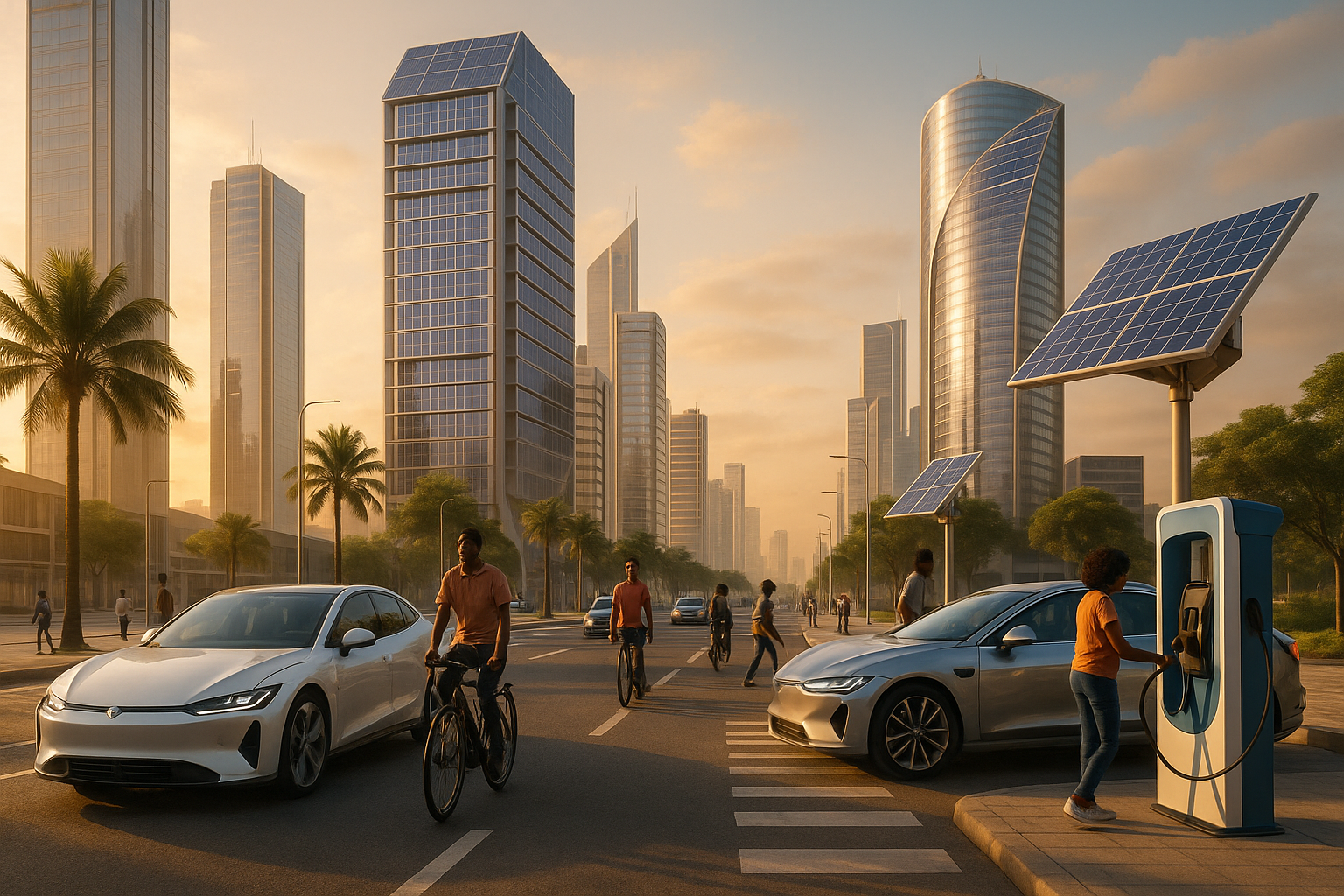
Africa is gearing up for a future where electric vehicles (EVs) could reshape transportation by 2050. Key drivers include urbanization, government policies, and renewable energy integration. Countries like Kenya and Ethiopia are already implementing measures like EV infrastructure mandates and bans on fuel-powered vehicle imports. However, challenges such as high costs, limited charging networks, and unreliable power grids remain. Solutions like local EV manufacturing, solar-powered charging stations, and policy reforms are paving the way for change. By 2050, EVs are expected to play a major role in urban mobility, public transport, and commercial fleets, though adoption rates will vary by region.
Electric cars in Africa – Is Africa ready for the global shift to electric vehicles?
Major Trends Driving EV Growth in Africa
Africa’s journey toward widespread electric vehicle (EV) adoption is gaining momentum, with several key trends reshaping the transportation landscape. These forces are steering the continent toward a cleaner, more sustainable future.
Population Growth and Economic Development
As cities across Africa expand and urbanize, the demand for environmentally friendly transportation is on the rise. With growing incomes in key regions, more consumers are expected to explore EVs, attracted by the promise of lower long-term fuel and maintenance costs.
Government Policies and Regulations
Government initiatives are playing a critical role in driving EV adoption. For instance, Kenya is making strides with its National Building Code 2024, which requires at least 5% of parking spaces in new constructions to be equipped with EV charging outlets. Meanwhile, Ethiopia has taken a bold approach by banning the import of traditional fuel-powered vehicles, a move aimed at reducing fuel import expenses and encouraging a shift toward electric mobility.
"As for accelerating the adoption of EVs, the panelists agreed that government policy is key. High import duties on electric vehicles were cited as a key constraint."
– ESI Africa
Despite these efforts, challenges remain. High import taxes and unclear regulatory frameworks continue to hold back infrastructure growth and make EVs less accessible to many consumers. At the same time, governments are working to support local manufacturing industries, creating jobs and boosting the domestic economy.
Power Grid and Infrastructure Expansion
The expansion of charging infrastructure is picking up speed across Africa, fueled by investments from both public and private sectors. The Middle East and Africa EV charging market, valued at $162.5 million in 2024, is expected to grow to nearly $380.7 million by 2029, with an annual growth rate of 18.56%.
A key focus is on deploying smart, connected chargers to avoid the pitfalls seen elsewhere. Industry leaders emphasize the importance of starting with intelligent systems to ensure long-term success.
"You’ve got to stop the installation of dumb chargers. You need smart, connected chargers to avoid what happened in the UK, where they had to ban 200,000 dumb units after rollout. We have the chance to get it right from the start."
– Winstone Jordaan, Director of GridCars
Additionally, modernizing power grids and integrating renewable energy sources are making EV charging more sustainable and economical. Collaboration between local governments and automakers is further streamlining the rollout of charging stations, aligning infrastructure growth with the increasing number of EV imports. These developments pave the way for future advancements in EV technology and design, setting a strong foundation for Africa’s electric mobility revolution.
Technology Advances and New Developments
With improved infrastructure and supportive policies laying the groundwork, technological advancements are set to reshape the electric vehicle (EV) landscape across Africa. These innovations are making EV ownership more practical and affordable, addressing challenges unique to the region. Key areas of progress include battery technology, charging infrastructure, and smart power systems.
Battery Improvements and Vehicle Range
New developments in battery technology, like lithium iron phosphate (LiFePO4) cells, are proving to be highly reliable in Africa’s hot climates. These batteries not only extend the driving range of EVs but also reduce charging times, thanks to ongoing research into fast-charging systems and advanced solid-state batteries. Additionally, local battery production is poised to lower costs while creating job opportunities across the continent.
Smart Power Systems and Vehicle-to-Grid Technology
Smart power systems are changing how EVs interact with electricity grids. By integrating EVs with African power grids, vehicle-to-grid (V2G) technology allows EVs to help stabilize electricity supply during peak demand or outages. Smart charging systems further improve energy efficiency by scheduling charging during off-peak hours. Bi-directional charging, meanwhile, enables EVs to act as temporary power sources in regions where grid reliability is a concern. In remote areas, the combination of microgrids and EV charging infrastructure is emerging as a self-sustaining energy solution.
Solar and Wind-Powered Charging Stations
Africa’s rich solar and wind resources are driving the creation of renewable-powered charging stations. These include solar canopy systems for public spaces and hybrid or off-grid solutions that incorporate energy storage. By pairing renewable energy with storage systems, these stations ensure a consistent power supply, even when weather conditions are unpredictable. This approach not only supports EV adoption but also aligns with Africa’s broader renewable energy goals.
Market Types and Regional Differences
The electric vehicle (EV) market in Africa is evolving in unique ways, shaped by differences in vehicle types, power systems, and regional characteristics. These variations highlight localized strategies that complement broader global trends and will influence EV ownership across the continent by 2050.
Vehicle Types and Power Systems
In African cities, battery electric vehicles (BEVs) are seeing increasing adoption, particularly for commercial use. Two- and three-wheelers are leading this shift, thanks to their lower running costs and simpler maintenance needs, making them an attractive option for urban mobility.
Hybrid vehicles are playing a transitional role in areas where charging infrastructure is still developing. They offer better fuel efficiency and help consumers ease into electrification without worrying about range limitations.
Plug-in hybrid electric vehicles (PHEVs) are a smaller but growing segment. These vehicles combine the benefits of electric driving for daily commutes with the reassurance of a gasoline engine for longer journeys.
In the commercial sector, electric buses and last-mile delivery vehicles are gaining traction faster than passenger cars. This growth is driven by lower operational costs and stricter urban emissions regulations, making electrification an appealing choice for businesses.
Leading African Markets
Certain African countries are actively driving EV adoption by leveraging their existing infrastructure and manufacturing capabilities. Some governments are using policy incentives to encourage the transition to EVs, while others are investing in renewable energy and modern production techniques to position themselves as future manufacturing hubs.
Urban centers are increasingly adopting electric two- and three-wheelers, offering efficiency and cost advantages. Additionally, initiatives like modernizing government fleets and forming partnerships with global manufacturers demonstrate a continent-wide commitment to EVs. These efforts reflect the varying approaches taken by different regions.
Regional EV Development Comparison
Regional factors play a significant role in shaping the pace and nature of EV adoption across Africa:
- North Africa benefits from established manufacturing industries and proximity to export markets, which drive interest in EV production and export opportunities.
- West Africa faces challenges with charging infrastructure, but its dense urban areas create demand for smaller, city-friendly EVs.
- East Africa is focusing on electrifying public transportation, supported by renewable energy projects and a growing tech ecosystem fostering local EV innovations.
- Southern Africa has relatively advanced automotive and charging networks, though economic constraints slow mass adoption. Industrial sectors are beginning to explore electric commercial vehicles.
- Central Africa struggles with limited infrastructure and political challenges, but its rich natural resources make it a key player in supplying materials for EV batteries.
These regional dynamics highlight Africa’s diverse and complex journey toward widespread EV use by 2050.
sbb-itb-99e19e3
Obstacles and Solutions for EV Growth
Even with promising trends, several hurdles stand in the way of widespread electric vehicle (EV) adoption. Tackling these challenges is crucial to meeting the ambitious 2050 goals.
Main Barriers to EV Adoption
There are a handful of key issues that need attention to maintain momentum in EV adoption.
- High upfront costs: EVs often come with a hefty price tag compared to traditional gasoline cars, making them less accessible, particularly in lower-income areas.
- Strong competition from used gasoline vehicles: The affordability and availability of used gas-powered cars continue to make them a popular choice, slowing the shift to EVs.
- Power grid reliability: In regions with frequent power outages, the practicality of owning an EV diminishes due to unreliable charging options.
- Limited charging infrastructure: A lack of public charging stations, especially in rural areas, limits the convenience and feasibility of owning an EV.
- High import duties and taxes: Tariffs and fees on EVs inflate costs, creating additional financial barriers for potential buyers.
Methods to Address These Barriers
Addressing these obstacles requires a mix of policies, partnerships, and innovative approaches.
- Policy reforms: Governments can encourage EV adoption by offering tax breaks, reduced import duties, purchase subsidies, and perks like free parking for EV owners.
- Public-private partnerships: Collaboration between governments, utility companies, and private investors can speed up the development of charging infrastructure, ensuring stations are placed where they’re most needed.
- Creative financing options: Programs like battery leasing or flexible loan structures can spread out costs, making EV ownership more manageable for consumers.
- Local assembly: Manufacturing EVs locally can lower production costs and create jobs, making them more affordable and accessible.
- Solar-powered charging solutions: Off-grid solar charging stations can provide a reliable alternative in areas with unstable power grids, ensuring consistent access to charging while lowering operational electricity costs.
- Regional cooperation and bulk purchasing: By working together, countries can negotiate better deals with manufacturers and share the costs of building infrastructure, leveraging economies of scale.
Problems and Solutions Summary Table
| Barrier | Impact | Solutions |
|---|---|---|
| High upfront costs | EVs remain out of reach for many buyers | Battery leasing, policy incentives, local assembly |
| Used vehicle competition | Gasoline cars dominate due to affordability | Flexible financing options, targeted incentive programs |
| Power grid reliability | Charging becomes unreliable in power outages | Solar-powered charging solutions, grid improvements |
| Limited charging infrastructure | Lack of charging stations limits convenience | Public-private partnerships, strategic infrastructure planning |
| High import duties and taxes | Tariffs drive up EV prices | Policy reforms, incentives for local manufacturing |
2050 Predictions and Preparation Steps
Looking at the trajectory of current policies and technological advancements, Africa’s electric vehicle (EV) market is expected to claim a growing share of the overall automotive industry by 2050. However, adoption rates will differ across regions, influenced by local policies and infrastructure. To support this growth, expanded charging networks and increased local manufacturing will be essential. Meanwhile, improvements in battery technology and charging infrastructure will make EVs more appealing to both consumers and commercial fleets.
EV Market Forecasts for 2050
By 2050, experts anticipate that electric vehicles will hold a notable share of Africa’s automotive market. Regions with strong governmental support and aligned economic development are likely to see faster adoption, while areas grappling with infrastructural and economic hurdles may experience a slower transition. These predictions highlight the importance of early and coordinated preparation across sectors.
Action Steps for Key Groups
Individuals can prepare by understanding charging requirements, evaluating range capabilities, and exploring financing options. Urban residents may find EVs increasingly practical for their daily needs, while those in rural or remote areas might consider hybrid vehicles as a transitional solution.
Businesses should start integrating EVs into their operations now. This includes testing electric delivery vehicles, installing workplace charging stations, and training staff to maintain EV systems. Logistics companies should also evaluate charging infrastructure along major transportation routes.
Governments play a pivotal role in driving EV adoption. Key efforts include reducing import duties on EVs, establishing clear standards for charging networks, and supporting training programs for EV technicians. Cross-border collaboration to harmonize standards will further simplify travel and connectivity across the continent.
Investors should look at opportunities in areas like charging infrastructure, battery recycling, and local EV assembly operations. With the growth of renewable energy – especially solar-powered charging solutions – the EV market in Africa becomes even more attractive for long-term investments.
How EV24.africa Supports EV Growth
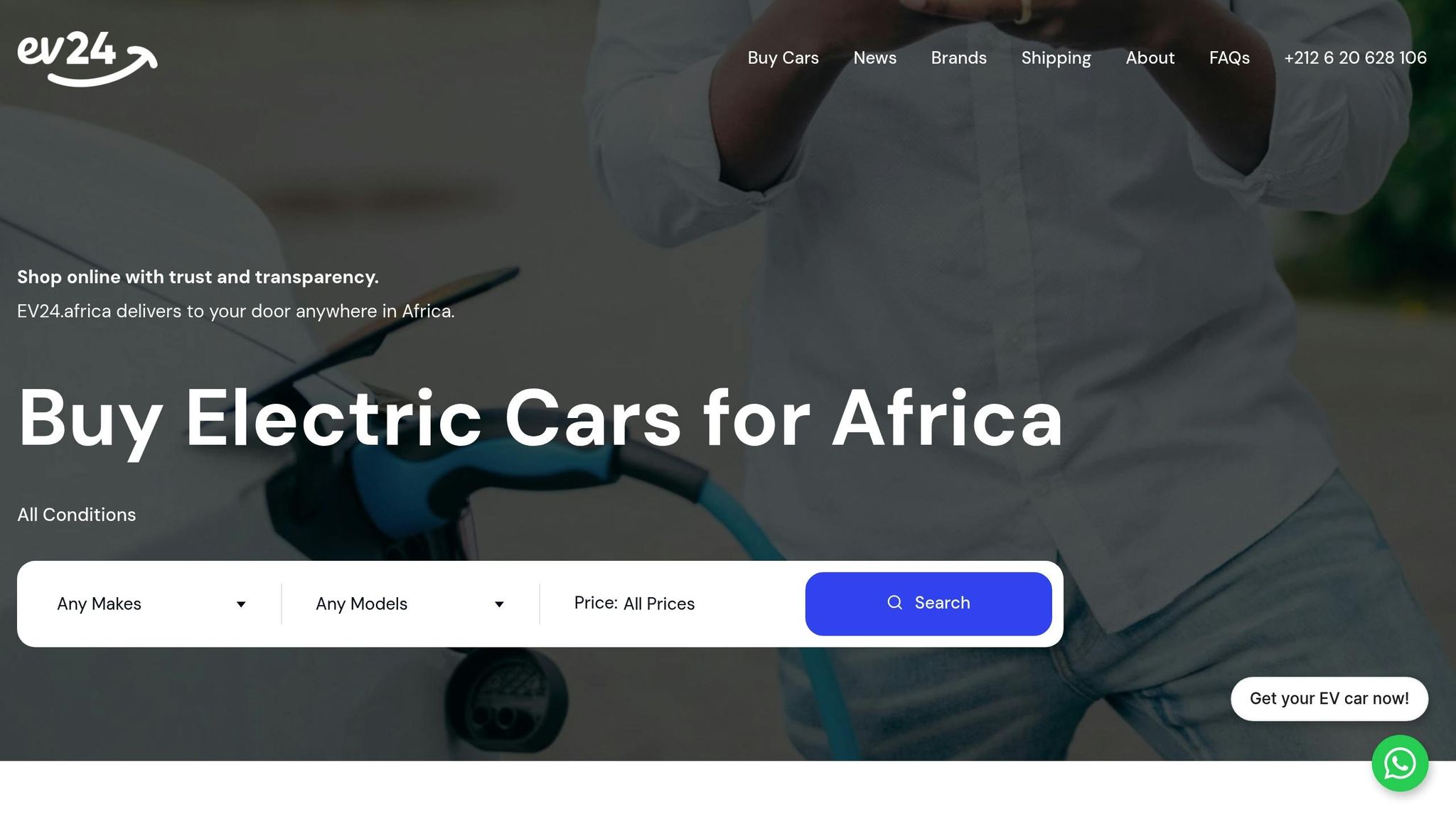
EV24.africa is actively contributing to the expansion of the EV market across Africa, offering flexible financing options, a diverse range of vehicles from top brands, and reliable delivery services in all 54 African countries.
The platform features EVs from leading global manufacturers such as Tesla, BYD, Leapmotor, ROX, Dongfeng, Geely, Hyundai, Toyota, and Suzuki. This ensures African consumers have access to high-quality electric vehicles on par with those available in more developed markets. With transparent pricing and expert car services, EV24.africa simplifies the transition to EV ownership. Their delivery services also improve access in areas where local EV dealerships are still emerging.
For dealers and businesses, EV24.africa provides tailored plans to help establish and grow local EV sales networks. By supporting both new and used vehicle sales, the platform is helping to create a strong secondary market – an essential component for sustaining long-term EV adoption across the continent.
Conclusion: Africa’s EV Transformation
Africa stands on the brink of a transportation shift, powered by advancements in technology, supportive policies, and growing infrastructure.
As these elements come together, the expansion of reliable power grids, renewable energy-based charging networks, cutting-edge batteries, and smart energy systems will make electric vehicles (EVs) more accessible. These developments will also allow EVs to seamlessly integrate into Africa’s broader energy landscape.
The pace and nature of EV adoption will vary across regions, but the impact will extend beyond personal transportation. It promises economic growth opportunities and cleaner, healthier urban environments.
Collaboration is key to making this vision a reality. Governments, industry leaders, and tech innovators must work together. For example, platforms like EV24.africa are already paving the way by offering access to quality EVs, along with financing and delivery options across all 54 African nations.
As Africa moves toward a greener and more efficient transportation future, ongoing progress and unified efforts will be critical to unlocking the full potential of EVs on the continent.
FAQs
What challenges could Africa face in adopting electric vehicles by 2050, and how might they be addressed?
Africa faces numerous hurdles in making electric vehicles (EVs) a common reality by 2050. Some of the main issues include scarce charging infrastructure, unstable power grids, steep upfront costs, and lack of strong policy backing. These challenges collectively slow down the continent’s ability to adopt EVs on a large scale.
Addressing these barriers will require a multi-faceted approach. Investing in renewable energy sources could pave the way for more sustainable charging networks. Governments can step in with incentives and policy changes to encourage adoption. Additionally, strengthening power grids, building public-private partnerships, and offering affordable financing solutions can lower costs and make EVs more attainable for both individuals and businesses.
How do regional differences shape the adoption of electric vehicles across Africa?
Regional differences significantly influence how electric vehicles (EVs) are gaining traction across Africa. In countries like South Africa and Morocco, the focus is on adopting more traditional EV models. Meanwhile, in East African nations such as Kenya, Rwanda, and Uganda, the spotlight is on two- and three-wheeler EVs, which are better suited to the urban transportation needs of these regions. These contrasts highlight the continent’s varied mobility demands and economic landscapes.
That said, the journey toward widespread EV adoption isn’t without obstacles. Limited charging infrastructure, inconsistent government policies, and economic inequalities continue to hold back progress in many areas. Yet, there’s a growing momentum driven by interest in renewable energy and creative local solutions, signaling a shift toward a greener transportation future for Africa.
How are government policies and renewable energy shaping the future of electric vehicles in Africa?
Government policies are playing a central role in encouraging the adoption of electric vehicles (EVs) across Africa. By introducing measures like tax incentives, reduced import duties, and funding for charging infrastructure, governments are making EV ownership more affordable and practical. These steps not only reduce the initial costs for buyers but also establish the essential systems needed to support widespread EV use.
In addition, many African countries are tapping into their rich renewable energy resources, such as solar and wind power, to power EVs. This approach decreases reliance on fossil fuels, lowers operational expenses, and promotes a cleaner, more sustainable transportation system. Together, these government initiatives and renewable energy efforts are laying the groundwork for the growth of EVs, creating benefits for individuals, businesses, and the environment.


